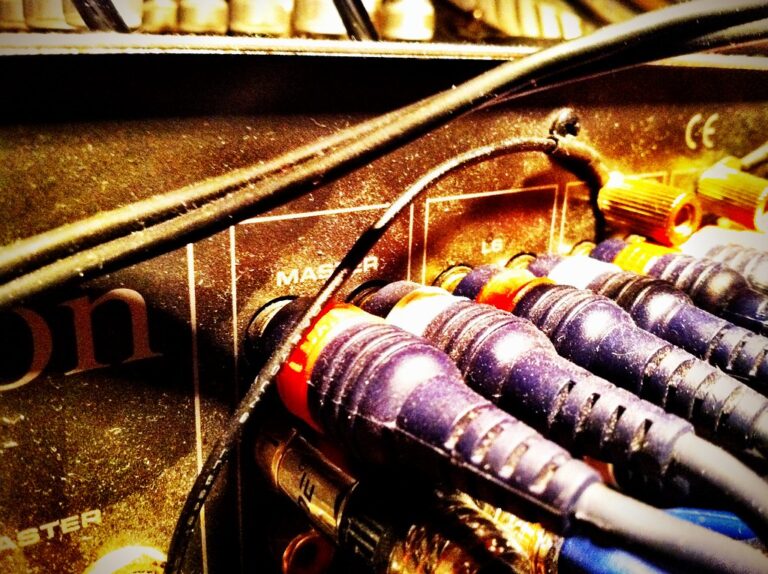Cable Maintenance: Cleaning and Preserving Your Audio Cables
Back in the day, maintaining audio cables was often overlooked, but in today’s tech-driven world, it’s an important aspect of ensuring high-quality sound. From preventing signal degradation to extending the lifespan of your equipment, proper cable care is a must. But how exactly does one go about cleaning and preserving these essential components? Let’s explore some practical tips and techniques that can make a real difference in your audio setup’s performance.
We are supported by our audience. When you purchase through links on our site, we may earn an affiliate commission, at no extra cost for you. Learn more.
Importance of Cable Maintenance
Proper cable maintenance is important for ensuring the best audio quality and preventing equipment damage. When it comes to cable maintenance, one important aspect is cleaning. Regular cleaning of your cables plays a significant role in improving conductivity and sound quality. Dust, dirt, and grime can accumulate on the surface of cables, leading to signal loss and distortion. By incorporating a routine cleaning schedule, you can prevent these issues and ensure your cables perform at their best.
Connector cleaning is another essential part of cable maintenance. Connectors are prone to oxidation and corrosion, which can hinder the transmission of audio signals. By keeping your connectors clean and free from debris, you can maintain a strong connection between devices and prevent any disruptions in the audio signal. Neglecting connector cleaning can result in poor audio quality and potential equipment damage.
Types of Audio Cables
Among the various types of audio cables commonly used in sound systems and recording setups, instrument cables serve the purpose of connecting guitars and other instruments to amplifiers for signal transmission. Instrument cables are characterized by their 1/4-inch connectors, which are often mono and shielded to prevent interference. These cables are vital for musicians and audio engineers, providing a reliable connection for instruments to amplify sound.
Microphone cables are another essential type of audio cable, specifically designed for connecting microphones to audio interfaces or mixers. These cables typically feature XLR connectors, known for their balanced configuration that helps reduce noise and interference. Microphone cables are indispensable in the world of audio recording and live sound reinforcement, ensuring clear and crisp vocal or instrument capture.
Speaker cables, on the other hand, are used to transmit audio signals from amplifiers to speakers for sound reproduction. These cables are constructed with thicker gauge wire to handle the power output from amplifiers without significant signal loss. Speaker cables come in various lengths and configurations to accommodate different sound system setups, making them a critical component for delivering high-quality audio output in various environments.
Understanding the distinctions between instrument cables, microphone cables, and speaker cables is fundamental for effectively setting up sound systems and ensuring excellent audio quality in professional and recreational settings.
Cleaning Supplies and Techniques
To maintain the best audio quality and performance, it is important to utilize appropriate cleaning supplies and techniques for audio cables. When cleaning your cables, here are some essential items and methods to take into account:
- Microfiber Cloths: These cloths are ideal for gently wiping down the surface of the cables to remove dust and dirt without causing damage to the delicate components. They provide a soft and non-abrasive way to keep your cables clean.
- Q-Tips with Cleaning Solution: Using Q-Tips dipped in a cleaning solution can effectively reach and clean the interconnects of your cables. This method guarantees ideal signal transfer by targeting hard-to-reach areas where dirt and grime may accumulate.
- Electrical Contact Cleaner: For power and speaker cable connectors, using electrical contact cleaners is recommended. These cleaners are designed to safely and efficiently remove debris, oxidation, and other contaminants that can impact the performance of your equipment.
Storage and Handling Tips
When storing audio cables, make sure they are placed in a cool, dry location away from direct sunlight to prevent damage. Proper storage is essential in maintaining the integrity of your cables. Utilizing the over-under coiling technique is highly recommended as it helps reduce twists and kinks that can damage the cables over time. This method involves alternating the direction of each loop, making sure the cable lays flat and untangled when in use.
Securing coiled cables with Velcro ties can prevent tangling and further protect the cables from unnecessary stress. It is important to avoid tight bends near connectors as this can strain the cables and potentially lead to breakage. By maintaining gentle curves instead of sharp bends, you can extend the lifespan of your audio cables significantly.
Consider using protective caps for connectors when the cables are not in use. These caps help shield the connectors from dust, moisture, and other elements that could compromise their functionality. By following these storage and handling tips diligently, you can prolong the life of your audio cables and make sure they continue to deliver high-quality sound without issues.
Troubleshooting Common Cable Issues
Inspecting audio cables for common issues allows for the identification and resolution of potential signal disruptions or connectivity problems. When troubleshooting common cable issues, it is essential to approach the task systematically. Here are three key steps to help diagnose and resolve problems effectively:
- Check Connectors: Begin by examining the connectors on the audio cables. Look for any signs of damage, such as bent pins or corrosion, which can impact the cable’s ability to transmit signals properly.
- Inspect Outer Jacket: Inspect the outer jacket of the cable for any cuts, tears, or wear. Damage to the outer jacket can expose the internal wiring to external elements, leading to signal loss or interference.
- Use Alcohol for Cleaning: If connectors appear dirty or corroded, clean them using isopropyl alcohol and a lint-free cloth. Alcohol helps remove dirt and grime without leaving residue that could further impede signal transmission.







